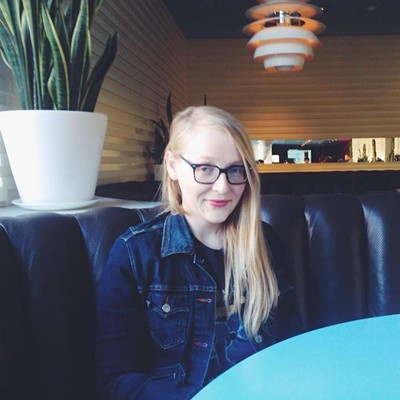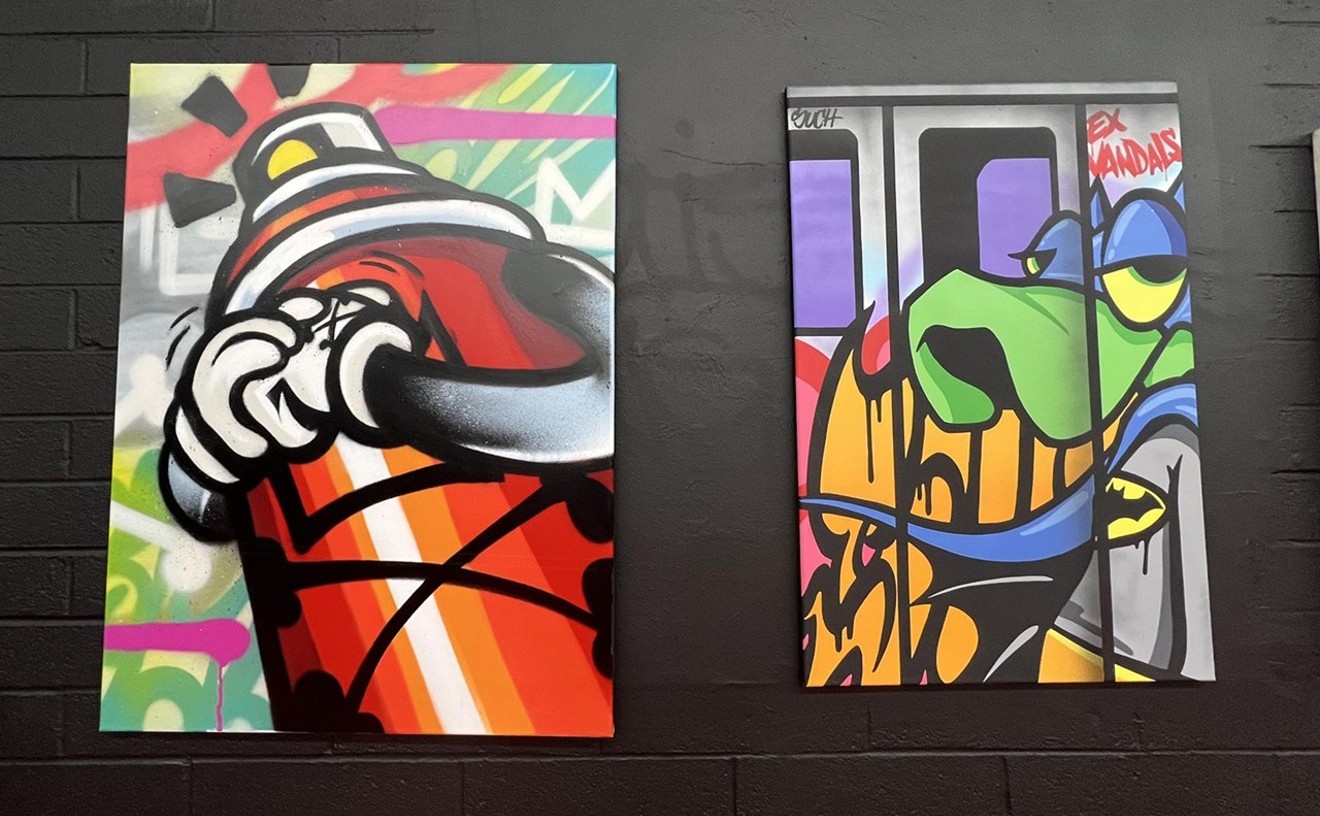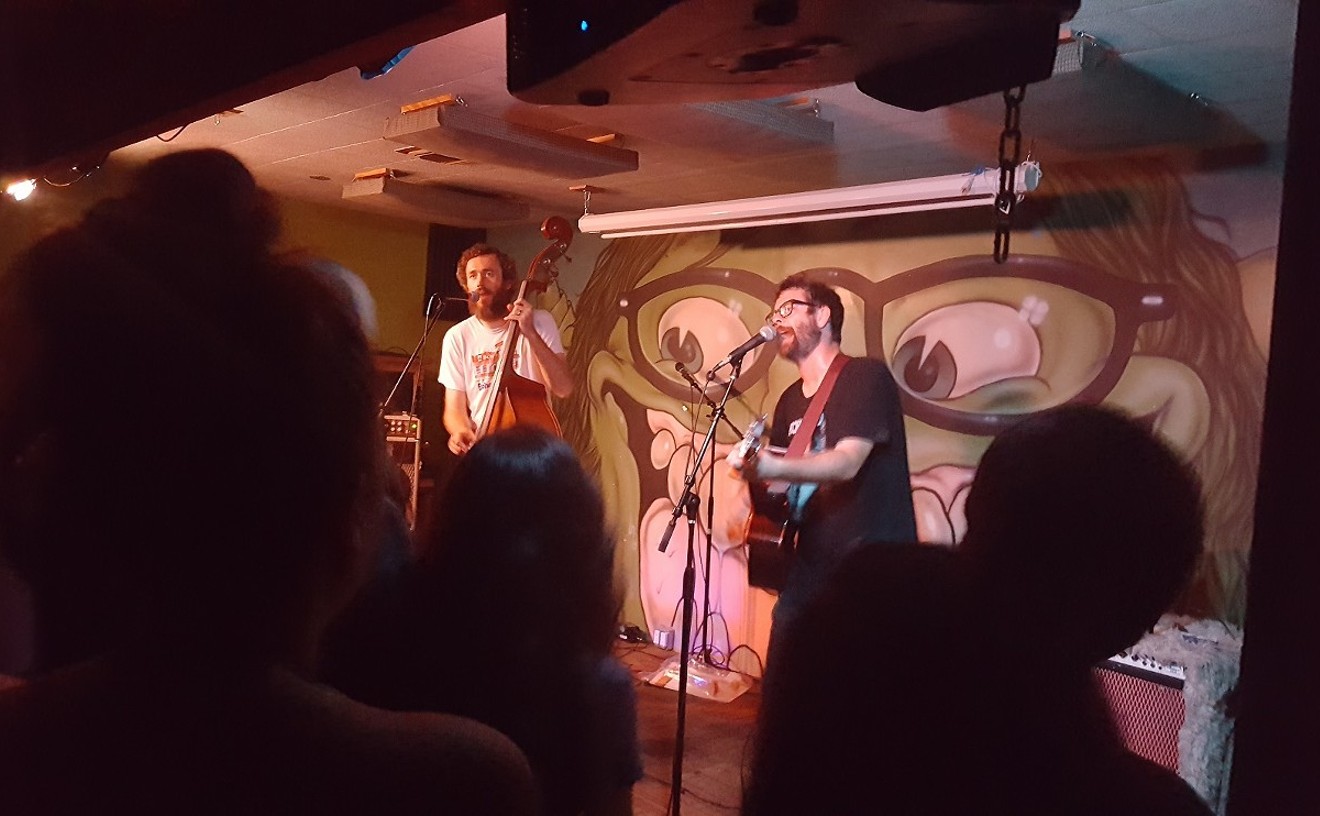The six-foot saguaros dangling from the ceiling in "Creature-Man-Nature" at Mesa Contemporary Arts look like they could descend on you at any moment, so you'll have to overcome the urge to duck while walking through the exhibition.
Up through April 28, the multimedia show features works by Mary Shindell, Carolyn Lavender, and Monica Aissa Martinez. Shindell crafted those ominous (though prickle-free) LED and Lucite Cacti (2013) in three sizes, addressing the nature aspect of the show, while Lavender takes on animals and Martinez portrays man (and woman). The premise is simple, with the three artists bringing trademark styles to their respective subjects.
In 2011, the group showed together in "What Goes On and What Takes Place" at Modified Arts. That show highlighted their not always riveting processes of creating the art that ended up on display. This time around, they've relegated recording the creative process to an ongoing blog, Formal and Informal (formalandinformal.wordpress.com). There you'll find documentation of the artists visiting each other's studios, discussing the show conceptually, and chronicling how the exhibition came together.
But your time would be better spent in the gallery — even though it's so crammed with art that it's tough to navigate. Because each artist has such a strong point of view and so much work to show, "Creature-Man-Nature" would have worked better broken into thirds. Still, all of its elements are worth investigating.
The exhibition was proposed to MCA curator Patty Haberman as a group show (something that Haberman doesn't see very often) to fill the museum's 700-square-foot North Gallery, a space that features Arizona-based artists exclusively. The blog was a major part of the pitched exhibition. Usually, artists approach the museum in hopes of showing solo. Sometimes the museum staff assembles visually complementary artists into groups so they can show together.
Since it's only sort of entertaining to scroll through Formal and Informal (though a three-dimensional model Shindell made to map out the show is nothing short of covetable), leaving the creative process in the workshop was a good call. Seeing the artists' finished products beats wading through the tedious steps taken to make them. There was no traditional collaboration, no group work. The artists don't share a studio. Each has her own vision. There was no precise plan when it came to what work they would show.
That's why it's easy to look at the three sections of North Gallery and wonder why Lavender's black-and-white scenes, Shindell's massive depiction of South Mountain, and Martinez's body studies belong together.
Shindell's installation There Is a Mountain (2013) is a digital drawing of South Mountain, dubbed simply Mountain (2013), and a fixture that holds the nine glowing and tubular Cacti that drop into the gallery's air space from the middle of the ceiling. Twenty-five feet wide, the dense drawing fills the far wall from corner to corner. The landscape includes swatches of gemstones and images of desert vegetation seemingly copied and pasted throughout pink and brown terrain — juxtaposing the surface of the mountain and what lies beneath. These details demand closer inspection and introduce the show's overarching theme: awareness.
The artist's fascination with the desert as an enveloping and mysterious environment is apparent. Stand about two feet outside of the gallery facing the mountain, at the center of the room's opening, and you'll see that the landscape's peaks and valleys align with the hanging cacti. With their bluish light, the cacti take on a UFO quality that makes the scenic view strange. It's beautiful, frightening, and complex, and it easily could stand alone in this gallery.
Too bad the cacti in Shindell's installation hang high and low — low enough to bump into unwittingly. If the other artists hadn't pumped up their canvas sizes, this wouldn't be an issue. But when trying to take in details of the larger works on display (which requires backing up — likely into the saguaros), Shindell's overpowering chandelier — the piece that infuses the exhibition with buzzing life — becomes intrusive.
Lavender worked on a larger scale than she typically does, balancing Shindell's piece with her painting Preservation Woods (2012), in which taxidermied animals inhabit a forest. Every stuffed beast included is one Lavender has encountered and photographed. The carefully drawn and painted scene is surreal — a mounted zebra head hangs on a tree, while a javelina is frozen in an eternal snarl.
Lavender's smaller graphite drawings are easier to absorb, because there's no need to back up to get a good look. Stehekin Deer 2 (2012) is striking, with a barely shaded white background that suspends three deer, one footless and two complete. They're Lavender's only portrayals of live animals in the show. Clocking in at one hour and 24 minutes is the video Urban Water (2012), a compilation of motion-triggered footage of birds and cats entering her yard. It's a linchpin tying together the themes of "Creature-Man-Nature," with animals adapting to nature inhabited by man. Her interpretation of creatures explores the human desire for closeness to animals, whether they're living, dead, or stuffed tchotchkes on a shelf. That crossover between humans and animals is reflected in Martinez's pieces on the opposite wall.
Martinez's colorful, introspective works examine the human body's inner workings in layers of acrylic, gouache, casein, and pencil on paper and canvas. The focal point of her offerings is a large-scale pair of human forms on paper, Body Female: A Self Portrait and Body Male (2011-2012), the latter of which is a depiction of the artist's husband with their cat. Martinez pits the brain against the pelvis, visualizing the internal conflict between intellect and instinct. While engrossing in detail, her portion of the exhibit feels a tad out of place because of her liberal use of layered color, compared to Shindell's set palette of earthy neutrals and Lavender's grayscale. But her manner of pulling out and examining ears and kidneys, among other body parts, reinforces the idea of increasing awareness through its milagro-style isolation.
The works in "Creature-Man-Nature" are unified by strong vertical imagery in Martinez's figures, Lavender's trees, and Shindell's cacti. Their subjects are diverse, but the complex pieces find common ground through intense introspection. With each piece, the artists reveal obsessions with their topics. Shindell and Martinez pull apart their subjects to reveal their insides, while Lavender collects very real specimens in her daily life to inhabit her unreal scenes. Together they suggest that one's self and surroundings both require further exploration. Shindell's mountain peak, with its plastic flora, and Lavender's lengthy video component are what make the exhibition more than an exercise in coexistence. They transform the space into a habitat — even if it's challenging to survey.











